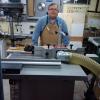Hi,
I have a problem with my G0543 planer which has been irritating me for a long time now and has come to a head so I thought I’d post here to see what you experienced folks do. I’m wondering if it’s a problem with they way I am using the machine, the way I have it tuned, or maybe an inherent problem with the planer itself or material problems, most like all of the above…
Anyway the problem is, some (not all) of my boards come out perfect and for the most part I am very happy with this planer – I can get uniform thickness on boards down to less than 1/100th of an inch variance. Some of my boards though, after running through my 8” jointer (and are quite flat on one side after running through the jointer) and then after surfacing on the planer, the ends of the boards about 2 3/8” of an inch from each end, come out of the planer about 2 or 3/64th thinner then the mid section of the board, and this leaves that characteristic ridge, or bump perpendicular to the grain, parallel to the board edges. I realize this could be a problem with warped boards and I know from experience that some boards will almost warp before my very eyes after I rip them and plane one surface down a bit on my jointer prior to dimensioning to thickness on the planer. This could be due to the very high humidity, I live in Michigan and have an open air garage shop. BTY I have been doing nothing but hard maple since I got the planer.
I’m wondering if It’s a problem with material thickness? My manual says I can go down to 3/16” but I have read that some folks don’t like to go less than 4/4 for planning, is the problem that just some boards even if they are 4/4 or ¾ flex easy and are not good candidates for planning? Or maybe a problem with machine set up?
I’d like to follow up with a second related question a bit later, regarding planer sleds, I am starting to build one and experimenting with it for greater than 8” wide boards to use the planer as a jointer, but first I want to see what I can do to mitigate the above before I get on to that issue thanks for any insights.




 Reply With Quote
Reply With Quote



